Cyclone
| ACA Cyclone 125 | |
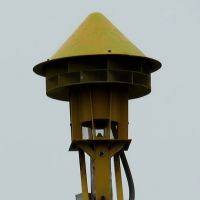 An ACA Cyclone 125, located in Kiel, WI. Image by FSThunderboltfan1000. | |
| Company | |
|---|---|
| Produced | 1968-2007 |
| Type | Omnidirectional Electromechanical |
| Sound output | 125 dB @ 100 ft |
| Frequency | 60 Hz |
| Horsepower | 50 hp |
| Voltage | 208-230/460 V AC 3 ph |
| Succeeded by | ASC Tempest |
| Documentation | Manual |
The Cyclone describes two powerful dual tone omnidirectional siren models that were produced by Alerting Communicators of America (ACA) and later American Signal Corporation after ACA's bankruptcy. At the time of its release the Cyclone was the most powerful omnidirectional siren on the market, and to this day still trades blows with much newer sirens such as Sentry Siren's 20VXT and 40V2T, and ASC's Tempest-121. It was the loudest omnidirectional siren ACA offered, being sold alongside their Screamer and Banshee sirens.
The Cyclone, along with the Penetrator-50 which shares its core, would have the longest production run of any ACA-designed siren, being produced for nearly 50 years from 1968 until its discontinuation in 2007.
History and design
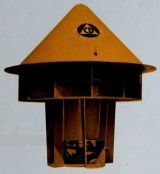
Designed by James Biersach, the Cyclone was first introduced in 1968 alongside ACA's original siren lineup. Originally sporting a strange conical shape as depicted in advertisements, the design was finalized to a more conventional shape by the time of its release. The Cyclone would see further design improvements in the 1980s.
The Cyclone is a simple siren in design, with the intake being on the bottom where the siren is mounted. Like all of ACA's sirens, the Cyclone uses a fiberglass housing that protects the siren from corrosion, giving it exceptional longevity compared to sirens built out of steel.
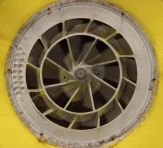
All Cyclones use an 8/12-port dual tone rotor and stator, with the motor being located above the siren underneath a conical fibreglass cover. All Cyclones use a 23⅞" chopper which utilizes a unique "dual-intake" design (which was also used on Federal's 10/12 500-SHTT models) which maximizes airflow to both rows of ports. While high in performance, this design is heavy and has a lot of drag when spinning which requires the siren to use a very powerful 3-phase Baldor 50 horsepower motor to bring it up to speed. The siren's rotor and stator are both directional to improve sound output when the rotor is spinning in the right direction, but if the motor is wired backwards (reverse wired) then air will be restricted to the rotor and the siren will sound muffled with a severe reduction in performance. The stator is cast with horns around every stator port, which matches the width of its fibreglass motor cover and projects the sound from each port individually.
Very few omnidirectional sirens match or surpass the Cyclone's sound output, such as the Fedelcode Type Mach. 10 (supposedly, this remains to be tested) and Sentry's 40V2T if their claims are accurate. Unfortunately, the Cyclone is also very power-hungry (with 240 V models pulling over 100 amps at start and a whopping 900 amps if running on 208V), costly to run, and lacks any sort of DC or single-phase options due to the immense size of its rotor. This means the siren is rendered useless if mains power is lost. As a result, newer battery backup equipped sirens such as the T-121 or Sentry's 7V8-B, 14V-B and 16V1T-B often end up replacing Cyclones despite a lower sound output. Even during its production run the Cyclone was heavily outsold by ACA's more cost-efficient options. Despite these flaws, many Cyclones continue to operate to this day, and proved popular as a nuclear or severe weather siren during their production run.
Models
There are two models of Cyclone:
Cyclone 120
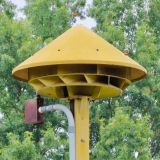
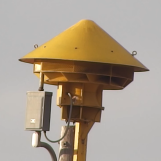
The Cyclone 120 was unveiled in November 1968, and was advertised with a far different design than what would be used in the final product. It was depicted as an 8/12-port dual tone single rotor siren, with both rows of stators facing a downward 45 degree angle, forming a conical shape towards the bottom. This was meant to disperse the sound downwards, which would increase its effectiveness near the siren. No units were ever produced with this design, and only exists in ACA's catalogue.
The Cyclone 120 would be redesigned before its release, with the top 8-port row no longer being angled downwards. The reason for this is so that the top 8-port row is able to project farther to increase the range of the siren, while the angled 12-port lower row would disperse sound more effectively near the siren. The intake design was simplified, being little more than a plus (+) shape under the intake hole, which would also serve as the mount. This would be the base design upon its release. The intake would be later redesigned, using a taller rounded design that allowed for the siren to be optionally equipped with a solenoid-operated damper, which would allow it to output a "pulse" signal. This revised intake design would also be used in three-signal Banshee and Super Banshee sirens.
The Cyclone 120 uses a 50 hp 480 V AC motor driving a single 8/12-port rotor. The siren was able to reach 125 dB at 100 ft, making it the loudest of ACA's omnidirectional sirens and outperforming every omnidirectional siren on the market upon its release. ACA would experiment with using a ring around the stator and a redesigned housing in an attempt to improve the performance of the siren further, but this was ultimately scrapped in favor of the Cyclone 125 redesign. The Cyclone 120 would end production in 1980, being replaced by the Cyclone 125. The Cyclone 120 is a rare sight today, with few active units remaining compared to the Cyclone 125. At least one unit is in private possession, though rendered inoperable and beyond repair from a lightning strike.
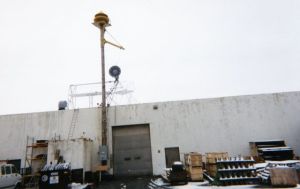
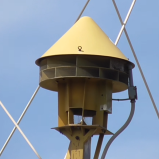
Cyclone 125
The Cyclone 125 is the successor to the Cyclone 120, introduced in 1980. The Cyclone 125 is a refined version of the Cyclone 120, with a redesigned intake, stator, and motor cover. A lip was added to the bottom of the housing that improved sound projection, and the bottom 12-port row of stator ports were also redesigned to be flush with the 8-port row instead of sloped downwards, which made both rows of ports project sound outwards equally. The Cyclone 125 had the same decibel rating of 125 dB at 100 ft as its predecessor, however it offered superior range thanks to the changes in its design.
The same year it was introduced, ACA also introduced the Penetrator-50, which was essentially a rotating Cyclone, using the rotor, motor and stator from the Cyclone 120. This was to replace the Hurricane 130 MKII. Like the Cyclone 120, the Cyclone 125 was available as a three-signal model with an optional damper for pulse signals. Late into the siren's production run, ACA experimented with adding a skirt under the stator which would help project the sound outwards, though it was ultimately chosen to go without the skirt for the rest of the siren's production.
The Cyclone 125 would be produced by ACA until 1994, when ACA went bankrupt. HÖRMANN bought ACA and reformed it into ASC. The Cyclone would be incorporated into the Screamer line as the SC-50, until 1998 when Dale Moeller bought back the company. The Cyclone 125 would then be renamed again to the C-125 (also referred to as the C-125-AC), and would be offered until 2007, when it was finally discontinued in favor of the Tempest series. Both the SC-50 and C-125 are identical in design and performance to the ACA-era Cyclone 125. The same year (2007), the P-50, which had been renamed the T-135AC, was also discontinued.